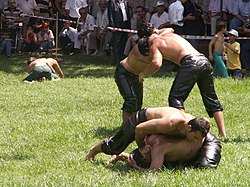This article needs additional citations for verification .(January 2009) |

A folk wrestling style is any traditional style of wrestling, which may or may not be codified as a modern sport. Most cultures have developed regional forms of grappling.
This article needs additional citations for verification .(January 2009) |

A folk wrestling style is any traditional style of wrestling, which may or may not be codified as a modern sport. Most cultures have developed regional forms of grappling.
Traditionally wrestling has two main centres in Great Britain: the West Country, where the Devon and Cornwall styles were developed, and in the Northern counties; the home of the Cumberland and Westmorland styles and Catch wrestling.




Luta marajoara e memória: práticas "esquecidas" na educação física escolar em Soure-Marajó https://e-revista.unioeste.br/index.php/cadernoedfisica/article/view/19262